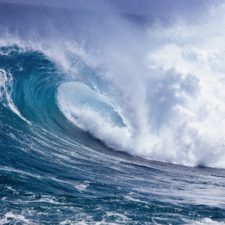Large-scale disasters had happened before but they were in the distant past, long before the majority of the population was born. The current generation knew little of real hardship. They had grown up during a time of prosperity and planned their lives for more of the same.
Among them was a mayor of a small town that remembered the hard times of his childhood. He also studied history and knew that someday history was bound to repeat itself.
As mayor, he began making plans to protect his town but his ideas were not always popular. Some people complained that what he wanted to do was a wasteful public works project. Others shook their heads at what they viewed as an old man’s folly. Most believed that since they had done the same as other towns that they were sufficiently prepared.
However, he persevered and before retiring the mayor saw his project completed. For twenty-seven years his legacy stood as an eccentric landmark and an occasional source of jokes.
All of that changed on March 11, 2011, when Japan was hit by a sixty-five foot tsunami. No defenses proved sufficient to stop the wall of rushing water that destroyed entire cities and took thousands of lives. The financial losses were in billions of dollars. No coastal town was spared. None that is, except for the small town of Fudai with its enormous concrete wall and floodgate. Fudai had weathered the perfect storm while surrounded by devastation on both sides, all because of the vision and determination of one man, Kotoku Wamura. While sea walls and flood gates are common to the coast of Japan, Wamura wanted Fudai’s to be nearly twice as tall as those built by neighboring towns. He had studied history and learned that long ago tsunamis much larger than existing structures had hit the coast of Japan. He knew that if it had happened before that it would eventually happen again.
The people of Fudai wanted to thank Kotoku Wamura for saving their lives but all they could do was lay flowers on his grave. He had died fourteen years before the tsunami hit.
At his retirement ceremony Wamura gave this advice, “Even if you encounter opposition, have conviction and finish what you start. In the end, people will understand.”
This story from recent history gives a great example for us to emulate and shows what one man can do if he is willing to adhere to principle. While I am not advocating that we build a wall around Eagle Mountain, I do believe in sensible preparation, in being ready for the unforeseen, in doing what’s right in the face of criticism and opposition, and in learning from history and the wise example of others.
Eagle Mountain will likely never see a tsunami but natural disasters such as fire, earthquake, or loss of electric power are quite possible.
Because Eagle Mountain is a growing and thirsty city the City Council has made sure that we have plenty of water supplied from multiple sources. However, our water system is vulnerable. Whether stored in tanks from wells or brought here from outside the city, our water is delivered to our homes by pumps powered by electricity. Fire, earthquake, or a power grid failure could result in the loss of electricity. Under such circumstances our water tanks would quickly go dry, leaving us all in distressed circumstances as we tried to find water for our families. To help our city be prepared, I asked the City Council to approve the purchase of generators powerful enough to run our water pumps until power can be restored. They are now installed, tested, and online to protect us in the event of an emergency.
This is one way I am striving to build our tsunami wall against potential disasters and protect our families.
“If ye are prepared ye shall not fear.”
